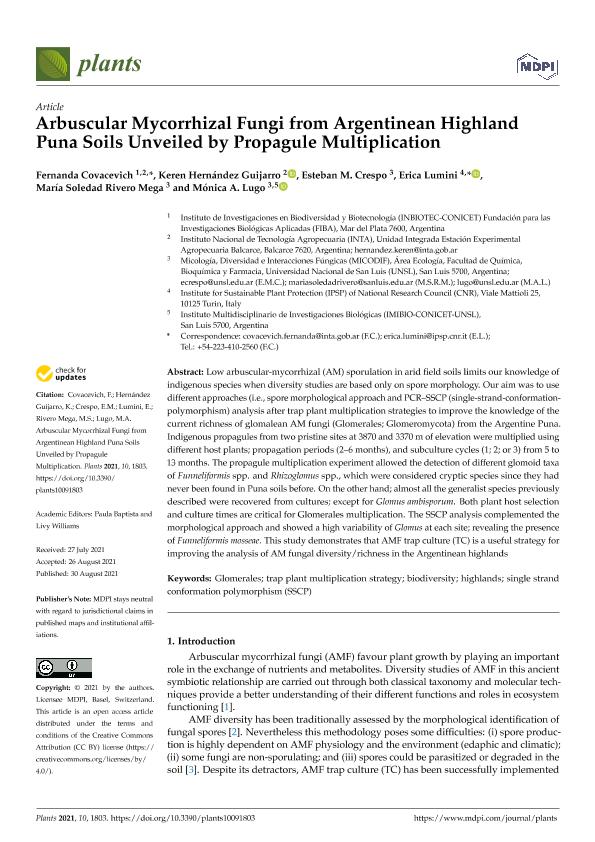Mostrar el registro sencillo del ítem
dc.contributor.author
Covacevich, Fernanda

dc.contributor.author
Hernández Guijarro, Keren

dc.contributor.author
Crespo, Esteban María

dc.contributor.author
Lumini, Erica
dc.contributor.author
Rivero Mega, María Soledad

dc.contributor.author
Lugo, Mónica Alejandra

dc.date.available
2022-01-10T17:38:00Z
dc.date.issued
2021-08
dc.identifier.citation
Covacevich, Fernanda; Hernández Guijarro, Keren; Crespo, Esteban María; Lumini, Erica; Rivero Mega, María Soledad; et al.; Arbuscular mycorrhizal fungi from argentinean highland puna soils unveiled by propagule multiplication; MDPI; Plants; 10; 1803; 8-2021; 1-14
dc.identifier.uri
http://hdl.handle.net/11336/149886
dc.description.abstract
Low arbuscular-mycorrhizal (AM) sporulation in arid field soils limits our knowledge of indigenous species when diversity studies are based only on spore morphology. Our aim was to use different approaches (i.e., spore morphological approach and PCR–SSCP (single-strand-conformation-polymorphism) analysis after trap plant multiplication strategies to improve the knowledge of the current richness of glomalean AM fungi (Glomerales; Glomeromycota) from the Argentine Puna. Indigenous propagules from two pristine sites at 3870 and 3370 m of elevation were multiplied using different host plants; propagation periods (2–6 months), and subculture cycles (1; 2; or 3) from 5 to 13 months. The propagule multiplication experiment allowed the detection of different glomoid taxa of Funneliformis spp. and Rhizoglomus spp., which were considered cryptic species since they had never been found in Puna soils before. On the other hand; almost all the generalist species previously described were recovered from cultures; except for Glomus ambisporum. Both plant host selection and culture times are critical for Glomerales multiplication. The SSCP analysis complemented the morphological approach and showed a high variability of Glomus at each site; revealing the presence of Funneliformis mosseae. This study demonstrates that AMF trap culture (TC) is a useful strategy for improving the analysis of AM fungal diversity/richness in the Argentinean highlands.
dc.format
application/pdf
dc.language.iso
eng
dc.publisher
MDPI
dc.rights
info:eu-repo/semantics/openAccess
dc.rights.uri
https://creativecommons.org/licenses/by/2.5/ar/
dc.subject
GLOMERALES
dc.subject
TRAP PLANT STRATEGY
dc.subject
SINGLE STRAND CONFORMATION POLYMORPHISM
dc.subject
HIGHLANDS
dc.subject.classification
Otras Ciencias de la Tierra y relacionadas con el Medio Ambiente

dc.subject.classification
Ciencias de la Tierra y relacionadas con el Medio Ambiente

dc.subject.classification
CIENCIAS NATURALES Y EXACTAS

dc.title
Arbuscular mycorrhizal fungi from argentinean highland puna soils unveiled by propagule multiplication
dc.type
info:eu-repo/semantics/article
dc.type
info:ar-repo/semantics/artículo
dc.type
info:eu-repo/semantics/publishedVersion
dc.date.updated
2021-12-03T19:45:32Z
dc.identifier.eissn
2223-7747
dc.journal.volume
10
dc.journal.number
1803
dc.journal.pagination
1-14
dc.journal.pais
Canadá

dc.description.fil
Fil: Covacevich, Fernanda. Consejo Nacional de Investigaciones Científicas y Técnicas. Centro Científico Tecnológico Conicet - Mar del Plata. Instituto de Investigaciones en Biodiversidad y Biotecnología; Argentina
dc.description.fil
Fil: Hernández Guijarro, Keren. Instituto Nacional de Tecnología Agropecuaria. Centro Regional Buenos Aires Sur. Estación Experimental Agropecuaria Balcarce. Área de Investigación en Agronomía; Argentina
dc.description.fil
Fil: Crespo, Esteban María. Universidad Nacional de San Luis. Facultad de Química, Bioquímica y Farmacia; Argentina
dc.description.fil
Fil: Lumini, Erica. National Research Council; Italia
dc.description.fil
Fil: Rivero Mega, María Soledad. Universidad Nacional de San Luis. Facultad de Química, Bioquímica y Farmacia; Argentina
dc.description.fil
Fil: Lugo, Mónica Alejandra. Consejo Nacional de Investigaciones Científicas y Técnicas. Centro Científico Tecnológico Conicet - San Luis. Instituto Multidisciplinario de Investigaciones Biológicas de San Luis. Universidad Nacional de San Luis. Facultad de Ciencias Físico Matemáticas y Naturales. Instituto Multidisciplinario de Investigaciones Biológicas de San Luis; Argentina
dc.journal.title
Plants
dc.relation.alternativeid
info:eu-repo/semantics/altIdentifier/doi/https://doi.org/10.3390/plants10091803
dc.relation.alternativeid
info:eu-repo/semantics/altIdentifier/url/https://www.mdpi.com/2223-7747/10/9/1803
Archivos asociados
